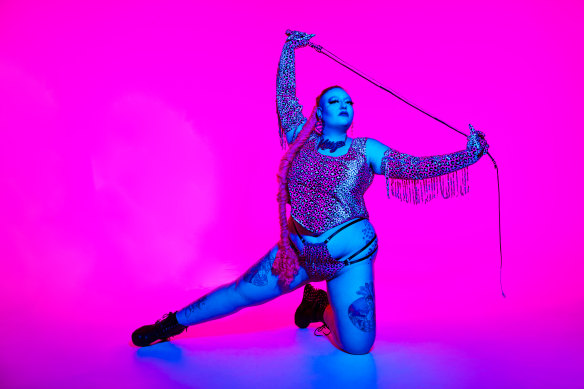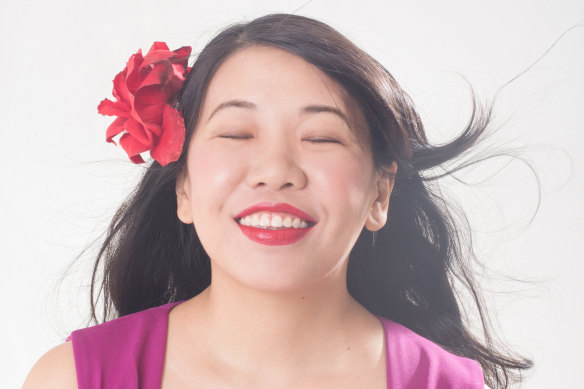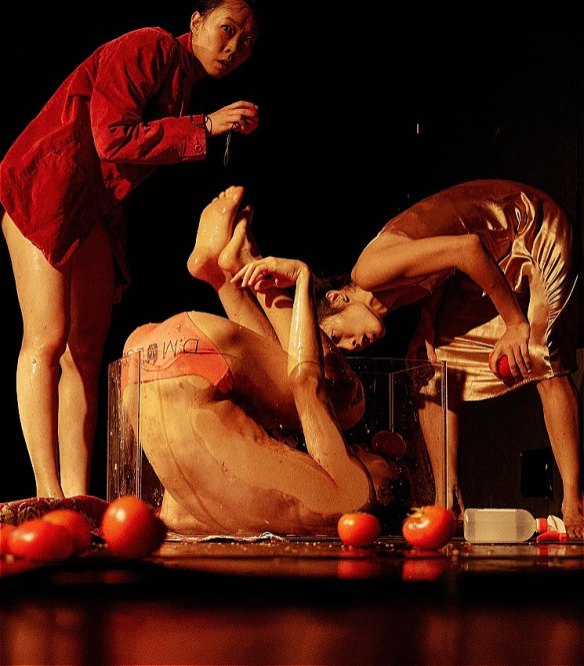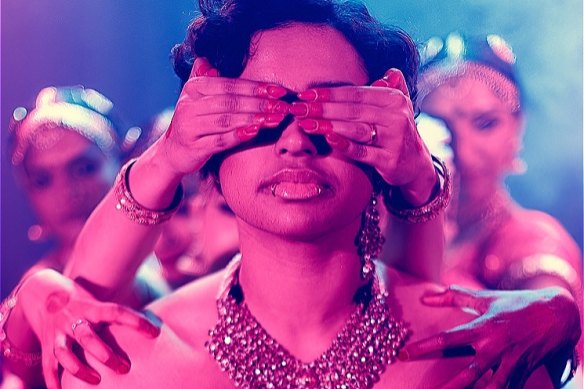We’ve been at it for millennia, but sex on the Fringe is something else
From disability to cultural taboos, this year’s edgiest festival steps into unspoken territory.
By John Bailey

Kitty Obsidian taks part in Disabled and Sexy, part of this year’s Melbourne Fringe. Credit: Joel Devereux
Artistic fashions wax and wane, but there’s one subject that will feature in any fringe festival. We might have been at it for millions of years, but there’s always something new to say about sex. This year’s Melbourne Fringe is awash with all things erotic, but as you’d expect, most of it’s a long way from the narrow version of sex that dominates the mainstream.
Jodee Mundy is curator of Disabled and Sexy, a party that will take over Arts House in North Melbourne for a night celebrating sexuality in all its diverse forms.
“I think intimacy and sexuality is both very public and very private,” Mundy says. “There’s a major industry that revolves around it. It’s on our screens and our televisions ... what is not seen as often is the visibility of deaf and disabled people having intimacy and sexuality in our public realm.”
Mundy says Disabled and Sexy is about reclaiming “that birthright that we all have to intimacy and sexual expression”. She’ll co-host the night with deaf drag queen Mademoiselle Coco, alongside artists drawing on the many forms that have long been associated with the erotic: “kink and seduction, striptease, burlesque”.
The party might be an opportunity to improve the visibility of under-represented artists, but it’s first and foremost a chance to blow off steam. “The deaf and disabled community spend the majority of their time advocating, constantly pushing and explaining ourselves,” Mundy says. “And I really wanted to throw a night where we didn’t have to do that. Where everyone could just really let their hair down, have a good laugh, dress up.

Sexologist Dr Martha Tara Lee performs in Orgasmic AF.Credit: Kristin Cornejo
“You’re going to meet people that you’ve never met before, you’re going to have conversations you’ve never had before, and it’s going to open your eyes to how awesome it is to be human. And how sexy we can all be too.”
Dr Martha Tara Lee’s solo show, Orgasmic AF, has a similar aim. Lee is Singapore’s leading sexologist, but she’s also very familiar with Melbourne (she holds two degrees from Monash University) and the contrasting attitudes to sex in each country.
“Asians tend to be much more inhibited, because of the lack of sex education. But with Australians, I find you have better work-life balance and people prioritise their relationships and sexuality a lot more.”
They’ll have plenty to learn at Lee’s Fringe debut, a collection of eye-opening tales, tips and humour she’s collected over her years at the front line of sexuality.
The show will feature audience interaction, but Lee won’t be hanging anyone out to dry. She’s used to making herself the butt of the joke. “I don’t have an issue laughing at myself and having people laugh at me. That’s the way I’ve been doing it for a really long time. I don’t want to embarrass my client during workshops and client stories are confidential, so a lot of times I end up sharing my stories.”
The mixed messages around sex often leave Lee’s clients in a state of confusion: “I get asked a lot how often people should be masturbating, how often they should be having sex. As if there’s some kind of a benchmark.”

Bianka Ismailovski’s Working Girl explores her career as a sex worker.
Perhaps the mismatch between sex in the media and our lived experiences in part explains the perennial appetite for art that promises to demystify the whole business. It’s certainly found an audience for Bianka Ismailovski’s solo show Working Girl, which explores her career as a sex worker.
“People love hearing sex work stories,” she says. “I think a lot of people struggle to understand how someone does that for a job because they can’t necessarily envision themselves doing it.”
Like many of her peers, Ismailovski’s sex education was skewed by the kind of advice she received from Dolly Doctor, an advice column in the Dolly teen magazine that guided young women between 1970 until 2016. “Sex for female pleasure was unheard of. I didn’t even know that I could orgasm, and so I didn’t have one until I was 21. Because it was just all about how to service him ... and I think for women especially, it’s a real learning curve to understand that sex requires a lot of vulnerability.”
Working Girl is comedy, but it is also potentially empowering. “Speaking about sex and normalising it and allowing people to know that, yeah, this doesn’t have to be something that lives in the shadows, it’s a pleasurable experience that we’re all doing, I think it actually helps audiences to feel seen and to allow them to feel OK about it,” Ismailovski says.

TOMATO is a three-hander exploring lust.
Chou Kuan-Jou’s dance education in Taipei was hardly an exercise in empowerment and self-expression. Students had to maintain the same haircut throughout high school and college, while their weight was posted publicly each week, with punishments meted out to those who failed to conform to expectations. She quickly realised she’d be forging her own path after graduation.
“I’m a lazy dancer, I’m not really into training, and what interested me more was performing arts ... What really inspired me was when I started to study feminism and started to reflect on my perspective on my body and my relationship experiences.”
Her Melbourne Fringe debut is TOMATO, a three-hander exploring lust. “Between friends we talk a lot about our personal sex lives, but in public or in a dance piece, to talk about lust or desire is not really common,” she says. “Maybe talk about sexuality or gender identity, but not about lust.”
The starting point for the work was the act of masturbation, and Chou wanted to capture the awkwardness and secrecy that usually accompanies solitary sex. “I don’t want to provide something beautiful about desire and the dancing body. I want to provide the reality of the difficulties, the insecurities, whether it’s sex or masturbating.”
TOMATO is playful and messy, extending in new directions each time it’s performed. Our attitudes towards sex are culturally loaded, and the show played differently in Taiwan (“the audience are really tense”), Chou says, than it did in Edinburgh (“the audience were half drunk and there was a lot of laughter”).

“We’re probably going to get into a fair bit of trouble doing this show,” says Temple of Desire director Govind Pillai.Credit: James Henry
That cultural baggage might also come into play with Temple of Desire, in which Bharatanātyam dance is given an erotic spin. While the show starts in a very spiritual place, director Govind Pillai says, “it ends up in a hot queer mess”.
Temple of Desire features 16 performers trained in classical Indian dance, where practitioners often begin their training at age four or five.
Breaking form can be tough when you’ve been immersed in a particular mode of dance for so long. “A lot of our dancers struggled to move in different ways because they said, ‘I’m not trained that way, that’s a little too salacious’,” Pillai says.
Pillai explained to them that Temple of Desire is not a departure from tradition but a return. The work “actually has its genesis in the temples of India about 3000, 4000 years ago, when the dances were performed for the idols as a sort of erotic expression of love for god and the divine. It was founded on this idea that it was a genuine and beautiful way to express affinity with the divine, to be one with the divine.”
The show is an attempt, Pillai says, to reconnect with an era when a person’s full self could be embraced. “There was gender diversity and sexual diversity in the way sensuality and spirituality were understood,” he says. “But today it’s very jarring, particularly for the Indian community, as practices have become sanitised and things are more chaste. We’re probably going to get into a fair bit of trouble doing this show.”
Words any Fringe artist could live by.
Disabled and Sexy is at Arts House, Oct 12; Orgasmic AF is at The Motley Bauhaus, Oct 14-20; Working Girl is at the Chinese Museum, Oct 8-12; TOMATO is at Dancehouse, Oct 2-5; Temple of Desire is at the Malthouse Theatre, Oct 4-5. Melbourne Fringe runs Oct 1-20; http://melbournefringe.com.au.
Get the best of Good Weekend delivered to your inbox every Saturday morning. Sign up for our newsletter.